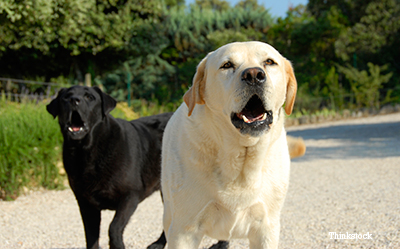
One of the most frustrating problems dog owners face is excessive barking. It’s also a common reason why dogs are returned to shelters or pounds1.
Dogs bark for any of a number of reasons and it’s not always bad. The most common reasons for barking are boredom and excitement. These barking episodes are usually brief and specific to a situation. None of these reasons tend to result in excessively annoying barking. Excessive barking can present real problems for owners and other people in the area.
Causes of excessive barking
In order to retrain a problem barker it is necessary to determine what factors may be triggering the behavior.
- Some breeds, such as terriers, may be more prone to barking although almost any breed can exhibit excessive barking.
- Some dogs bark because of physical distress if they are hot, cold, hungry or thirsty. (It can be a dog’s way of vocalizing distress.)
- Dogs may become a problem barker due to insufficient exercise (the dog’s pent-up energy is released through barking.) Click here for some creative pet exercises!
- Dogs may be bored, excited or anxious (again, the dog is seeking attention).
- Dogs may be frustrated (needing social and/or mental stimulation).
- Improper confinement may lead to excessive barking (restrictive tethering, being locked in a pen alone for long periods, lack of shelter).
- Excessive barking may be prompted by environmental cues (other dogs barking, passing cars, sirens, storms, etc.).
How do you make excessive barking stop?
[Editor’s Note: You should speak with your veterinarian or a veterinary behaviorist when trying to alter behavior. Otherwise, you can risk making the problem worse.]
Literally volumes have been written about correcting barking behavior. As with any problem, it is important to understand the root cause. There are steps that can be taken to control or curb the problem barking.
Focus on reinforcing your dog for the behavior that you want instead of barking. For example, if your dog barks in the yard at passing people, cars, etc, you can teach him a good “come” cue and reinforce him for responding (you need to teach it when the dog is not overtly stimulated by whatever makes him bark and then slowly add distractions). Avoid using things the dog doesn’t like when he barks, as this could make the problem worse or create additional behavioral problems. You also want to remove any reinforcement for barking, so if your dog barks at you for attention turn your back and ignore him. Praise him when he’s quiet.
Recently, a novel approach in treating a variety of behavioral disorders of dogs and cats using pheromones has seen success. As part of a comprehensive approach including environmental management/enrichment, pet training and owner education and in some cases specific behavior medications, pheromones may be helpful in managing behavioral problems. Dog-appeasing pheromone (DAP) is a naturally occurring pheromone which was initially extracted from lactating bitches. DAP has been recommended to decrease stress due to separation anxiety, hospitalization, fireworks and thunderstorms and to alleviate motion sickness.
Discovery News recently reported that a new pheromone product has been developed to help curb excessive barking. Formulated by Texas Tech scientist John McGlone, the key ingredient is androstenone, which is a pheromone actually produced by male pigs.
When confronted with excessive barking or other behavioral problems in your pet it is important to get advice from your veterinarian, and only use medications or products that have been prescribed by your veterinarian.
If you have any questions or concerns, you should always visit or call your veterinarian -- they are your best resource to ensure the health and well-being of your pets.




